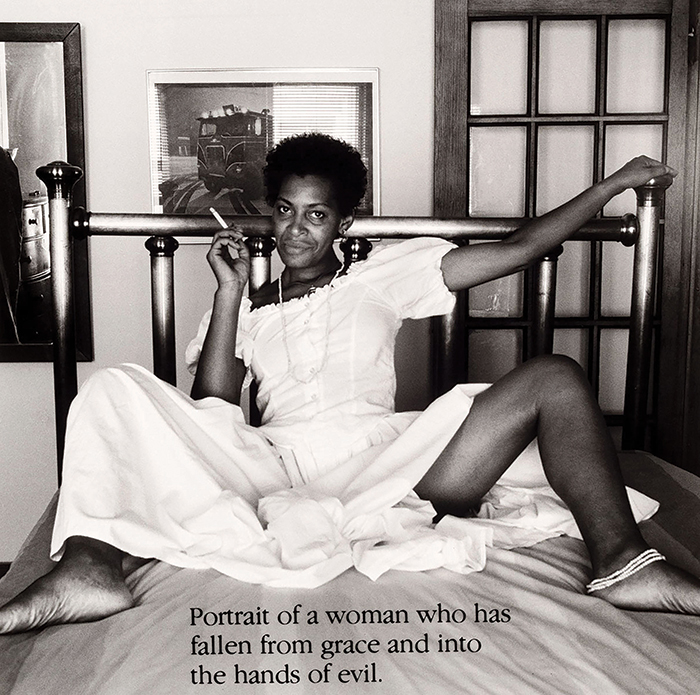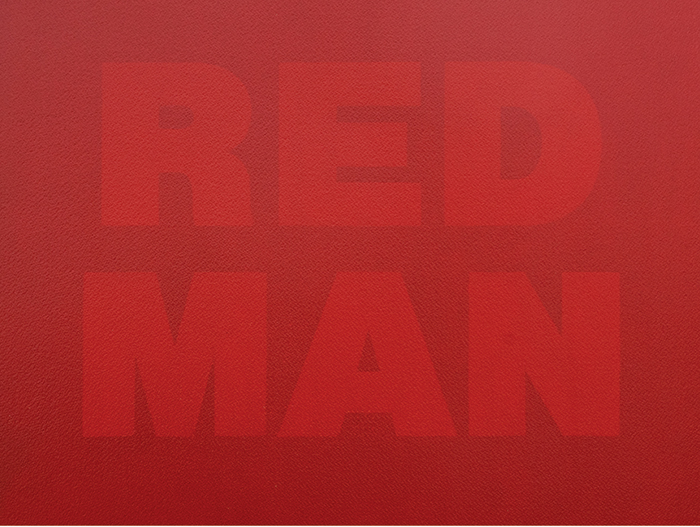A Conversation Not a Confrontation
Photography has long been a tool to record the injustices of the past in order to inspire justice in the future. Historically, photos could be relied on as documents of truth. Today, when the very concept of truth is called into question, both digital and analog imaging can still capture a searing moment, such as the beating of an unarmed black man by police. Or it can take a more circuitous route, requiring a deeper engagement, such as the work of Massachusetts-based artist/photographer Eric Gottesman and New York–based conceptual artist Hank Willis Thomas, founders of For Freedoms (featured in Art New England’s November/December 2018 issue).

For Freedoms (Hank Willis Thomas and Emily Shur in collaboration with Eric Gottesman and Wyatt Gallery of For Freedoms), Freedom from Want, 2018, archival pigment print, edition 5/10. Currier Museum of Art, Manchester, NH. Museum Purchase: The Henry Melville Fuller Acquisition Fund, 2018.30. Courtesy of the Currier Museum.
Gottesman and Thomas’s vision undergirds and permeates two major New England exhibitions focusing on photography and social justice that opened this fall and extend into 2020. We Are For Freedoms is the show at the Currier Museum of Art. And For Freedoms is also the name registered with the government as a “political entity” co-founded by Gottesman and Thomas. It is the first artist-run, nonpartisan PAC (political action committee) in America. The Currier exhibition is a citywide collaborative effort, pushing the work out into the world via strategically placed artist-designed billboards, lawn signs and text-based works featured on bus shelters across Manchester, NH. It is part of the For Freedoms 50-state initiative, launched in June 2018, to promote ways that artists and institutions can encourage and deepen public discussions and understanding of civic issues. Be Strong and Do Not Betray Your Soul at the University of Vermont’s Fleming Museum is a photography show of work by 47 artists from the Light Work collection. The exhibit, guest-curated by Gottesman and Thomas, can be viewed as a complement to the duo’s For Freedoms initiative.
Photography today is ubiquitous. Author, philosopher and social commentator Louis Hyde asks whether a work of art is changed by the way it is treated. We have Tumblr, Instagram, Snapchat, Facebook, Twitter and the whole worldwide web of interconnectedness to disseminate images and inspire or incite action. In this environment, does art have the power to influence how we see the world and how we act? Does a single image have as much impact now as it did in 1865 at the beginning of the photographic age or any time prior to the digital now? If the answer to these questions is yes, how do we counteract the inertia that results from the numbing of our senses to all the images of injustice that we are bombarded with every day?

For Freedoms (Hank Willis Thomas and Emily Shur in collaboration with Eric Gottesman and Wyatt Gallery of For Freedoms), Freedom of Worship, 2018, archival pigment print, edition 5/10. Currier Museum of Art, Manchester, NH. Museum Purchase: The Henry Melville Fuller Acquisition Fund, 2018.30. Courtesy of the Currier Museum.
Gottesman and Thomas make clear their belief that participant democracy is the solution. They believe art is an instrument that wields power, and that art, in particular photography, is inextricably bound to the political nature of society, and the way to influence society for the better is through art. Both Gottesman and Thomas participated in residencies at Light Work, a nonprofit artist-run collective located at Syracuse University established to provide direct support to emerging and underrepresented artists working in photography and digital imaging via residencies, publications and exhibitions. The 47 artists in the Fleming exhibition were selected from over 350 who all participated in the residency program.

Carrie Mae Weems, Portrait of a Fallen Woman, 1988, gelatin silver print. Courtesy of Light Work.
While Be Strong and Do Not Betray Your Soul and We Are For Freedoms represent a shared vision of the role art plays in society, the methodology, the installation and the way audiences engage with the works in these exhibitions diverge. We Are For Freedoms is direct and unapologetic about its activist stance, while Be Strong and Do Not Betray Your Soul is as nuanced and open to interpretation as is its title, which was taken from the work of Charles Biasiny-Rivera who completed this piece combining photography, text and drawing during his Light Work residency in 1992. The image is very personal. The handwritten script below the image feels like we are looking at a page taken from the artist’s journal. The message is poetic rather than explicit as is the diaphanous 168 Months Out of a Life Sentence (2009) by California artist Amy Elkins. Without the title as a clue, one would have no idea that this 20-x-16-inch inkjet print of deep blue open sky migrating to orange at the bottom of the frame relates to themes of incarceration, isolation and capital punishment.
The relationship of the subject to the photographer raises issues of power and control. Who gets to speak for whom in telling the visual narrative of a time and place? Photographs of “exotic” peoples taken primarily by white, Western, usually male ethnographers are deeply entrenched in our colonial past and still occasionally find their way to the pages of magazines such as National Geographic. Branded Chest (2003), a platinum print from the B®anded series by Hank Willis Thomas, is formally elegant while the message of the Nike logo literally “branded” on the naked chest of a black, male torso hits you on the head like a hammer. In this case, both the photographer and his subject are black and the references to a historical past condoning ownership of black bodies and our current enslavement to corporate culture become united in this powerful image. The installation team at the Fleming has managed to honor the integrity of the individual pieces presented in this disparate selection of work while maintaining cohesion of the exhibition as a whole.
Visual literacy, knowing how to read the story of pictures, is essential to understanding the world. As a vehicle to encourage critical thinking, For Freedoms uses Norman Rockwell’s iconic 1943 illustrations of the four universal freedoms first articulated by Franklin Delano Roosevelt—freedom from want, freedom of speech, freedom of worship and freedom from fear—as the keystone of its programming. Each image has been reinterpreted and photographed with some of the artist members of For Freedoms playing the roles of Rockwell’s original subjects, creating a more nuanced image of what it means to be an American. A selection from the more than 80 new downloadable versions of these collaborative works reflecting the rich diversity of America today are included in the Currier exhibition along with the original Rockwell posters.

George Longfish, Self Portrait of an Indian, 2005. Bus shelter design by For Freedoms. Courtesy of the Currier Museum.
Audience engagement and initiating discussion of the thorny issues of American core values is the goal at the Currier. Enough (2019), a digital drawing of letters in American Sign Language by Christine Sun Kim seen from the perspective of the signer, is one of ten provocative artist-designed billboards placed at locations across the city of Manchester, NH. Kim is a sound artist who has been deaf since birth. The red-on-red text image Portrait of an Artist (2005) by George Longfish, an artist of Seneca and Tuscarora heritage, speaks to questions of identity, particularly of indigenous people in the United States. His work will be featured on downtown bus shelters. These images, along with other public art installations in the show, are intended to raise awareness and stimulate questions during four town-hall style facilitated discussions in the exhibition space exploring themes of immigration, destigmatizing substance abuse, underrepresented voices in the art world and freedom of worship including indigenous perspectives and sacred lands. An interactive “digital quilt” will allow museum visitors to include themselves in the exhibition.
Five members of For Freedoms will be artists-in-residence at the Currier to help facilitate this labor-intensive program. Currier curator Samantha Cataldo defines her role in the project as “looking back and forward. Since FDR stated those four freedoms and Rockwell painted their visual manifestations, where are we now?” Cataldo is enthusiastic about the potential for audience engagement through the multifaceted programming of We Are For Freedoms. She emphasizes the importance of timing against the backdrop of the New Hampshire primary elections. She says, “Freedom can be read as being both red and blue. Through art, we want a conversation not a confrontation,” an important achievement in this highly politicized moment.
We Are For Freedoms
Currier Museum of Art
Manchester, NH; currier.org
Through March 1, 2020
Be Strong and Do Not Betray Your Soul: Selections from the Light Work Collection
Fleming Museum of Art
Burlington, VT; uvm.edu/fleming
Through December 13, 2020
Cynthia Close is a contributing editor for Documentary Magazine and writes regularly for Art New England and several other publications.
